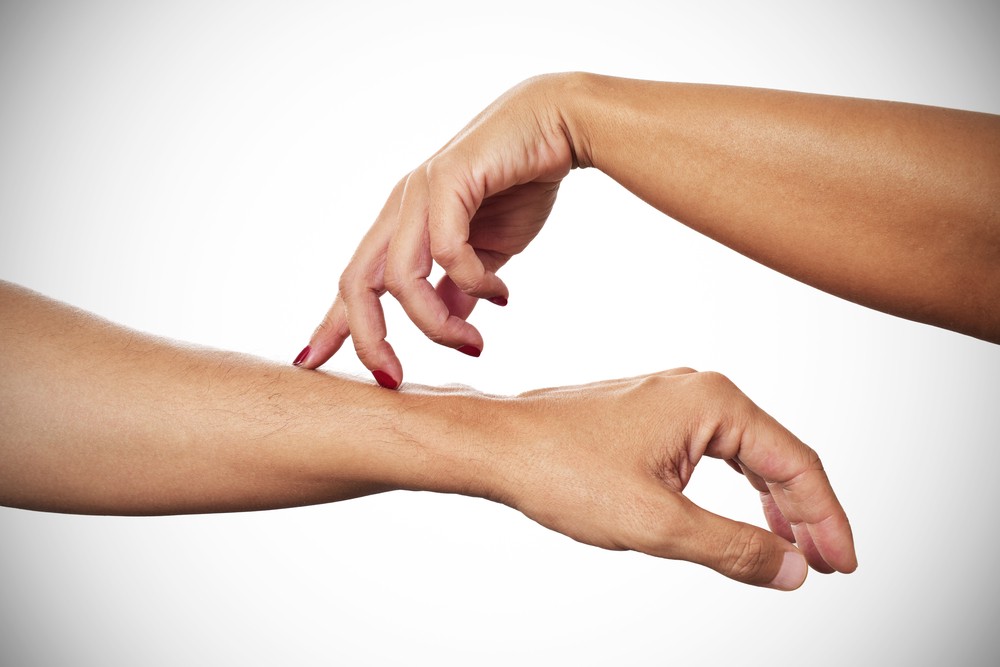Welcome to Sexpert?s Guide to Tickling Fetish and Sexual Tickling!

The official terminology for tickling fetishism is known as knismolagnia (or knismophilia or titillagnia[i]) which is sexual arousal derived from tickling someone or the sensation of being tickled themselves.[ii] Knismolagnia, comes from Knismesis, which is a light form of tickling like when a bug tickles the hairs on your arms, whereas gargalesis[iii] is the term for heavy tickling, which is intended to produce laughter.
Tickle ? is to give pleasure or gratify.
Tickling is a harmless practice that most of us have enjoyed innocently as infants and children, with games like ?This little piggy?, and ?Tickle Monster?.
As teens and young adults, tickling fights are often part of our introduction to playful touch as a sexual gateway to flirting, feeling up your girlfriend or fondling a newfound crush.
Tickling can be a fun way to become intimidate with someone, to touch, to tease and to flirt.
Tickling can be very childlike, amusing, exciting, and even erotic to some. To others it can be your worst nightmare, or even used as a punishment.
So, When Does Tickling Become a Fetish?
Tickling can be either a sexual interest or sexual fetish (paraphilia) in adulthood depending on your definition.
What?s the difference? Really, not much.
A sexual interest can turn into a paraphilia depending on how intense the fixation on it becomes and if the activity causes problems in your life. Most often, a fetish is seen as a harmless sexual interest if it doesn?t hurt anyone.
Violet Blue, co-author of ?The Fetish Sex Guide?, says that sexual fetishes are the ?standard-issue?.
?When you look at cultural stereotypes of what constitutes ?normal? sex, pretty much anything you do outside of married heterosexual missionary intercourse can be considered ?deviant? [and] everyone with genitalia and a brain?[iv] has a sexual fetish.
Rather than ?deviant?, Blue believes fetishes are ?magical?:
?When someone has a sexual fetish, it means that for them an object, manner of dress or specific scenario takes on a magical quality, has deeper meaning, and becomes part of their favorite sexual experiences ? or are sometimes absolutely required for satisfying sexual release.?[v]
Fetishes become problematic when the fetishist feels they can?t honestly share their interest with their partner and/or fulfill their fantasy. That leads to hiding their sexual impulses in the closet or repressing them, feelings of guilt, feeling like a freak, or by seeking unhealthy ways to live out their fantasies. When a person does not have a healthy outlet for their fetish, this can also lead to dangerous, extreme or destructive behaviour or activities.
What is Tickling Fetishism?

The official terminology for tickling fetishism is known as knismolagnia (or knismophilia or titillagnia[vii]) which is sexual arousal derived from tickling someone or the sensation of being tickled themselves.[viii] Knismolagnia, comes from Knismesis, which is a light form of tickling like when a bug tickles the hairs on your arms, whereas gargalesis[ix] is the term for heavy tickling, which is intended to produce laughter.
Definitions from ?Tickling?, by C R Harris, University of California:
Gargalesis: Laughter-inducing tickle elicited by a somewhat strong pressure repeatedly applied to certain ticklish areas on the body. This form of tickle cannot be self-induced.
Knismesis: Type of tickle that is elicited by a light movement across the skin and is not usually associated with laughter. The sensation can be readily produced in the self.[x]
Definition: Knismolagnia refers to sexual urges, arousal or fantasies involving tickling.[xi]
As far as fetishes go, knismolagnia is said to be one of the ?most obscure?[xii], and least researched of the paraphilias, and is basically harmless. However, people who have it often prefer tickling over other sexual activities including intercourse. In fact, no sexual activity needs to be involved what-so-ever, and some people can orgasm from tickling pleasure alone. Others don?t even need to be touched and can get turned on just by watching someone get tickled or by tickling someone else.
How to Know If You Are a Knismophiliac?

?Tickling provokes laughter through the anticipation of pleasure.? ? Charles Darwin
If you have intense, recurring sexual urges associated with tickling, being tickled, or ticking another person, and it is the only way you can get turned on or reach orgasm, you may be a Knismophiliac or Ticklephile.
Symptoms of Knismolagnia[xiii]:
- Sexual arousal gained from being tickled
- Sexual interest in tickling
- Recurring intense sexual urges involving tickling
- Sexual arousal associated with tickling
If you are a Ticklephile, you may fall into one of these categories[xiv]:
Tickle Top ? The person who tickles, or tickle tortures another with the object of forcing the victim, usually restrained and helpless, to laugh hysterically, cry, scream, urinate, ejaculate and even pass out from prolonged intense tickling. Usually done with consent for erotic sexual gratification, but sometimes used as effective torture of prisoners.
Tickle Bottom ? The victim, usually restrained, of tickle torture, either with consent by a tickle top for exercise or sexual gratification or by others as torture to obtain information or for sadistic pleasure. If very ticklish the ?bottom? suffers acute agony from the body?s automatic reflexes, such as hysterical laughter, screaming, crying, muscle spasms, urination, ejaculation, and even convulsions and loss of consciousness. Common in BDSM, (bondage sado-masochism) practice, the tickle bottom should be in good physical health because severe tickling can cause strokes and seizures.
Among ticklephiles, the terms ?Ler? and ?Lee? are also used to label a tickler or ticklee.
The good news is, tickling is not dangerous. Unless it involves rough, excessive tickling that can become painful; is non-consensual (some people can?t stand being tickled); or it becomes problematic: so obsessive to the point that it interferes with your life, work, happiness, health or relationships.
The bad news? You can?t self-tickle yourself to laughter. Unless you are schizophrenic, because ?their brains can?t differentiate between self-generated and externally generated touches?[xv].
The solution? Find yourself a tickler partner who enjoys tickling as much as you do!
Why Do People Get Turned On By Tickling?

?Tickling is symbolic for motion, for removing things from their complacency. When somebody is tickled, they may try to fight their reactions, but it is unlikely they will be able to remain still. They will start to fidget. They will suddenly find themselves cracking a smile, no matter how hard they try to remain in their stoic stance. They will be removed from whatever state of control they are in.?[xvi] ? ?Igniting Your Inner Tickle?, by TickleWriter
First of all, not everyone is ticklish. To some, being tickled is an extreme turn-off, and can even feel painful. To others, they may feel nothing at all. And, then some people are ticklish only at certain times or on certain parts of their body. In fact, in one study only 32% of the respondents enjoyed being tickled, 32% were neutral and 36% didn?t like it at all.[xvii]
Why people are ticklish at all and laugh when tickled has been the focus of serious debate from philosophers, scientists, researchers and thinkers including Charles Darwin, Plato, Aristotle, Francis Bacon and Galilieo Galilei, to name a few. And, we are still trying to figure out why people laugh when tickled, which you can read about that in this article: ?Why we laugh when we are tickled?.[xviii]
Tickle scientists have even gone so far as to research what area of the brain lights up when you tickle a person?s feet while strapped to an MRI brain scanner.[xix] It sounds like a cruel bit of torture to me. Imagine being strapped into an MRI and trying to remain still while someone tickles your feet!
And, according to G. Stanley Hall and Arthur Alli? in the Journal Article, ?The Psychology of Tickling, Laughing, and the Comic?[xx], just pretending you are about to tickle someone can induce laughter.
Strangely enough, feeling ticklish is not unique to humans either. Apes, Bonobos, monkeys and mice seem to enjoy being tickled, and apes even play tickle games.[xxi]
Ways to Explore Tickling
Knismolagnia Kink

As mentioned above, ticking can be explored as a BDSM activity that includes restraints, bondage, tickling with hands, or other toys such as feathers and erotic ticklers. It can be a form of play, foreplay, humiliation, dominance and submission, torture or punishment, depending on your desired intention.
Tickling in BDSM can also be a form of sensation play, or a way to induce forced orgasm (if the ticklee is sexually aroused by tickling). It often involves bondage, or being held down, or is used with a safe word without restraint. Tickling may be used with other forms of impact play or sensation play toys as well.
Erotic Tickling

There are numerous ways you can play tickle games with someone.[xxx] Then there is erotic tickling. This can be just a playful type of flirting that can be done any time during the day fully clothed. Or, it can be used as foreplay to lead up to the main event.
Erotic tickling can be used as a part of sensation play. You can tickle with your fingers, with your tongue, with your lips, blowing on the skin, with your hair or with a tickle toy like a feather.
Erotic ways to tickle include:
- Blowing softly in someone?s ear.
- Licking around the outer ear and ear lobe, then quickly sticking your tongue in your lover?s ear.
- Running your finger tips softly around someone?s hairline or at the back of their neck to give them goosebumps and erotic chills.
- Blowing down the back of neck and spine.
- Softly tickling the underside of the knees with light spider fingers.
- Playful squeezing the sides of the kneecaps.
- Pinching, licking or nibbling the toes.
- Blowing on the fleshy part of the belly with your lips to make a farting or buzzing sound.
- If you have long hair, draping your hair over your lover?s body and slowing dragging it over them so just the ends are touching the skin.
- Using a feather, or feather duster, straw, hairbrush, Q-tip, artist paintbrush, electric toothbrush (or vibrator) or other tickle instrument like a Wartenburg wheel on your partner?s feet, or other ticklish spots. (Incidentally, Pteronphilia is sexual arousal to being tickled by a feather. According to Wikipedia it is derived from the Greek word ?pteron? meaning feather or wing.)
- Tickling the armpit (also called a douhini) ?is the tickle of the inside of an exposed armpit. The Douhini-er must then yell Douhini to further surprise the victim. Usually accompanied by a slight waver of the pointer finger. In other cases a Douhini can also be a jab to the armpit but that technique is usually frowned upon.?[xxxi]
Erotic Places on the Body to Tickle

There are lots of places on the body that can be ticklish. The most popular include the feet, the under the arms, and the sides of the rib cage. But, don?t limit yourself to just these areas. Be playful, experiment and try different places as well as different types of touch from soft and barely touching, to full blown tickling.
Don?t forget to try out the genitals (vulva, clitoris, mound of Venus, or penis and testicles in men), breasts, nipples, inner thighs, back of neck, throat and pulse point, under chin, knees, cheeks, palms of the hand, waist and bum. You never know where your sweetheart?s sweet spot could be hiding!
How To Tickle Your Partner

You may not think that there is a right or wrong way to tickle, but according to ticklephiles there is.
Consent: First, make sure you have consent. Maybe you like being tickled, but your lover may actually hate it. Don?t go there without their permission unless you want to seriously turn them the F off. If you try to sneak up and tickle someone without their consent it may feel like an attack, especially if you don?t know the person well.
Talk About It: Ask your partner where they like to be tickled. Do they have any areas that are off limits for them? Do they like light and sensual, or crazy intense tickle-gasms?
Safe Word: This could be as simple as ?stop!?, or if you are playing a scene you may want to use a safe word like ?RED?, so the tickling doesn?t become unbearable.
Mood: Make sure you are both in a playful, lighthearted mood to start. Tickling when you are not in the right mood can also be a turn off.
Touch: Start with a light, barely-there touch and work your way up to more pressure. Start slow and work up to a frenzy.
Repetition and Variation: Use repetition when you find their ?spot? and concentrate in that area. But, you should also use variation for surprise to create more impact and give them some relief once in a while as well.
Have Fun!: Be playful, explore and have fun. Afterall, tickling is all about laughter and having fun. Remember what it was like to be a child again, and laugh!
Original Article published at Sexpert.com: http://www.sexpert.com/featured/tickling-fetish-what-is-it-and-how-to-sexually-tickle-your-partner/


